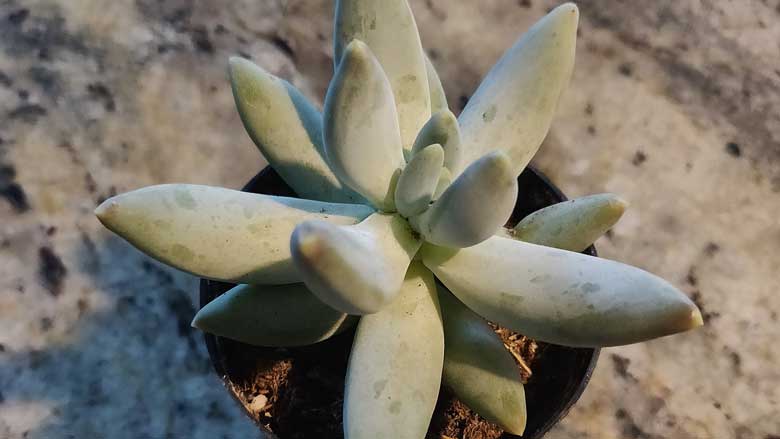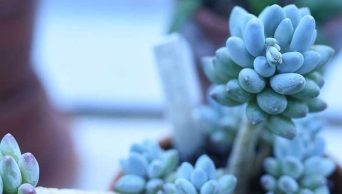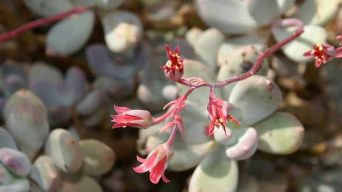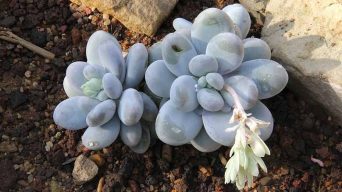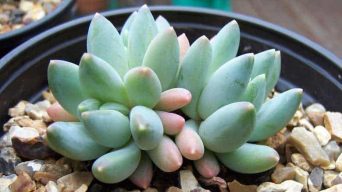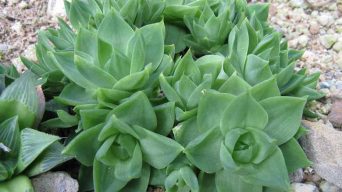Pachyphytum bracteosum is an excellent choice for anyone looking to grow their succulents.
If you want a beautiful succulent in your home or office, then this is the perfect one for you!
It’s easy enough for beginners but still has plenty of exciting features that will keep any gardener interested.
This guide will teach you all about the Pachyphytum bracteosum, from where it comes from and what it looks like to how to take care of and propagate it.
Overview
Pachyphytum bracteosum is a perennial succulent from the Crassulaceae family native to Mexico. It is most commonly known as:
- Silver Bracts
- Silverbracts
- Moon Stones
- Moonstones
This Pachyphytum species is a succulent that can grow up to 12 inches (30 cm) tall with silver-grey leaves and produce spikes of flowers.
This type of succulent plant has large leaves that are obovate and can be anywhere from 4.4″ (11 cm) to 7.8″ (20 cm) long and 2″ (5 cm) to 3.7″ (9cm) wide.
The Pachyphytum bracteosum plant has an inflorescence that produces flowers with red petals and a bluish-green tint.
How To Care for Pachyphytum Bracteosum
Pachyphytum bracteosum care is simple and easy. You won’t have any problems if you know your way around your succulents.
Below you’ll find the most important information you need to know about caring for Pachyphytum bracteosum.
Sun Exposure & Light Requirements
Pachyphytum bracteosum is a succulent plant that thrives in full sun to partial shade. The ideal exposure is partial shade, where the plant gets filtered sunlight to partial sun.
Your Pachyphytum will look best if your plant gets at least 6 hours of sunlight each day. If your plant doesn’t receive enough light, your plant may be leggy and spindly in appearance.
Succulents need to have a lot of sun exposure, but they also need protection from the intense heat your Pachyphytum bracteosum may encounter if your plant is placed near an east or west-facing window.
When your succulent plants are outdoors, your plants may not be able to handle the harsh, full sun your garden receives each day.
Your succulent leaves will burn, and your plant may even dry out if placed in intense sunlight for too long.
If your plant is being grown outdoors, consider moving it to a shadier part of your garden if it is exposed to too much direct sunlight.
When your Pachyphytum bracteosum is indoors, your plants may not get enough natural light, or your plant isn’t positioned near a window with plenty of natural sunlight.
You’ll need to place your plant near a south-facing window that receives a lot of sunlight if your goal is to have your plant grown indoors.
When your indoor plants get enough bright light, your succulents will be healthy and grow well. If your plant isn’t being given enough natural sunlight, your plant may not look as good indoors.
Watering Requirements
Pachyphytum bracteosum is a succulent which needs to be adequately watered and needs little water.
In general, you should allow your plant soil to dry out before watering your plant and avoid overwatering your plant because it can cause root rot or stem rot.
When watering your plant, you should also avoid getting water on the Pachyphytum bracteosum leaves. This can cause your Pachyphytum bracteosum leaves to rot off.
Soil Requirements
The Pachyphytum bracteosum plants need well-draining soil like a cactus soil or a succulent soil mix.
The ideal potting mixture for your succulents is a mixture of 50% coarse sand and 50% peat moss or coir fiber mixed with some perlite (to improve drainage).
Do not exceed more than 25% perlite because excessive amounts of it will cause your pots to dry out too fast, which can be potentially harmful to your plants in the long run.
Temperature and Humidity
The Pachyphytum bracteosum succulent is regarded as a plant that poses low requirements with regard to temperature and humidity.
However, it does require the right environment to survive.
This Pachyphytum species lives best in a temperature range of 68° – 80° Fahrenheit during the day and 50 °- 70° Fahrenheit at night.
It also requires 40% relative humidity levels.
Pachyphytum bracteosum loves the heat but dislikes cold drafts, so protect your plant from direct exposure to cool or cold winds during the winter months.
The night temperatures can drop by up to 10 degrees Celsius, and your plant will still be fine when exposed to this change. This does not mean you should expose your plant to frost, or your plant will die!
Fertilizing
The Pachyphytum bracteosum care is simple in regards to fertilizing these plants.
They only need to be fertilized once per month during the growth period or as required.
Fertilizer should be a diluted liquid fertilizer at half strength, with a ratio of one teaspoon per gallon of water. This should also be used on your succulents that are in bloom too.
Potting and Repotting
Most of the time, your Pachyphytum bracteosum will be fine in smaller pots, and you won’t have to repot your plant to keep it healthy.
However, when your plant grows too big for its pot or your pot is just too small, you’ll need to repot your Pachyphytum plant.
Pachyphytum bracteosum plants like to stay in small pots. They hate being over-potted, and your plant will suffer if you repot it too often.
However, your succulent plant needs a pot that’s large enough for your plant to grow into, and your plant grows best when it’s in a pot that allows for good drainage.
Your choice of pot will depend on your plant’s size, your preference, and your climate zone.
Succulents need porous pots that allow for good drainage to prevent root rot. Clay or terracotta pots are your best bet, although plastic or wooden containers also work fine.
Pruning
Pruning your Pachyphytum bracteosum is not necessary. It is only necessary to prune your plant if it is rotting, the leaves are turning black, or your plant isn’t growing.
Pruning your plant will help your Pachyphytum bracteosum compactness and health.
The only pruning your plant needs is removing dead leaves and leaves which are rotting.
Pruning your plant will give your plant more energy to grow, compact your Pachyphytum bracteosum and help it develop a better root system.
Pests and Diseases
Knowing your succulents can be very helpful in preventing pest and disease problems.
Porous-rooted plants like the Pachyphytum bracteosum are susceptible to root rot, especially when not adequately watered or if they are overwatered.
Pests like aphids, mealybugs, and scale can hide on your Pachyphytum bracteosum plant for a long time without being noticed until it grows too big.
If the leaves turn brown or you see tiny white cottony masses on the plant, then it’s likely that pests are to blame. Pests may also be responsible for causing your plant to appear yellow and unhealthy.
If your Pachyphytum bracteosum succulent has a lot of dead leaves, it’s probably because of the mealybugs or scale sucking on your plant’s juices. For this situation to be resolved, you’ll need to remove the affected areas from your plant. This means your plant will need to be pruned.
You can prevent your Pachyphytum bracteosum succulent from getting sick by placing your plant in well-drained soil (a loose cactus potting mix is ideal.
Also, a spray of water once or twice a month should keep your succulent healthy and growing properly.
How to Care for Pachyphytum Bracteosum in Winter
To take care of the Pachyphytum bracteosum during the winter, your goal should be to protect your succulents from the cold.
This cold-sensitive succulent requires winter protection if you live in a place with freezing winter temperatures (USDA hardiness zone 7 and under).
Pachyphytum bracteosum plants are most vulnerable to frosts and freeze when the temperature is between 32ºF (0ºC) and 50ºF (10ºC).
When your plant is subjected to these temperatures, your succulent could be damaged or killed.
Fortunately, your Pachyphytum bracteosum can be protected from cold temperatures with the proper care. Follow these steps to protect your succulent from freezing temperatures:
1. Bring your Pachyphytum bracteosum indoors
During the colder months, your plant should be brought inside your home, where it will be protected from freezing conditions.
2. Water your Pachyphytum bracteosum
Water your Pachyphytum bracteosum sparingly.
During the winter, your plant will not need much water to stay alive and healthy. In fact, overwatering your succulent can harm your plant by causing root rot or other problems.
3. Place your Pachyphytum bracteosum in a sunny area
To keep your plant healthy and strong, your succulent should be placed in a space that receives ample sunlight.
In this way, your plant will have the energy it needs to stay healthy and alive during wintertime.
4. Move your Pachyphytum bracteosum away from your heat source
Your succulent could be burned or severely damaged if your plant is near a fireplace, radiator, or other heat source.
Be sure to move your plant away from these heat sources so that your succulent can stay safe and warm.
5. Do not mist your plant
Since your succulent is a cold-sensitive plant, you should not mist your Pachyphytum bracteosum with water.
Water droplets left on your plants leaves can freeze and cause your succulent to develop ice crystals.
How To Propagate Pachyphytum Bracteosum
The Pachyphytum bracteosum succulents can be easily propagated by leaf cuttings and seeds.
How to Propagate your Pachyphytum Bracteosum by Leaf Cuttings
Remove a leaf from your Pachyphytum bracteosum and allow it to callous for a few days.
Plant your succulent leaf in your well-draining soil with the fleshy side down and water regularly.
Your succulent will start to sprout from your leaf in 2-3 weeks.
How to Propagate Your Pachyphytum Bracteosum from Seeds
Pachyphytum bracteosum can also be propagated through seeds.
The Pachyphytum bracteosum seeds need to be planted in the spring and watered often to prevent drying out.
To start your Pachyphytum bracteosum plants from seeds, remove the seeds from your succulent plant by using your thumbnail or palm of your hand to press on your succulent’s outer covering. The seeds will then easily pop out in your hand.
The seeds of your succulent plant should be thoroughly cleaned before planting. Use a bowl of water and add your seed; stir it around for about 10 minutes at least, and the succulent’s covering will rub off, making your job easier.
The seeds of your succulent plant should be planted with your well-draining soil but not covered and watered every day.
You will know your seed has germinated when your succulent’s green sprout tips are about 1/2 cm high.
When your Pachyphytum bracteosum plant is about 3 inches tall, transplant your plant into your permanent pot or garden.
Is the Pachyphytum Bracteosum Toxic?
The Pachyphytum bracteosum is not toxic to people or animals.
However, it has sap that can irritate your eyes and skin if you get it on your hands or touch your eyes. Wear gloves and be careful when handling your plant.
Final Thoughts
Pachyphytum bracteosum succulent plants are perfect for people who have limited space or live in apartments where they cannot garden outside their home but still want the beauty of plants inside their living environment!
These plants make excellent additions to your garden or home decor because they require little care but give so much beauty back in return!

